A comprehensive macaron troubleshooting guide with photos, possible causes and how to avoid the most common macaron issues!
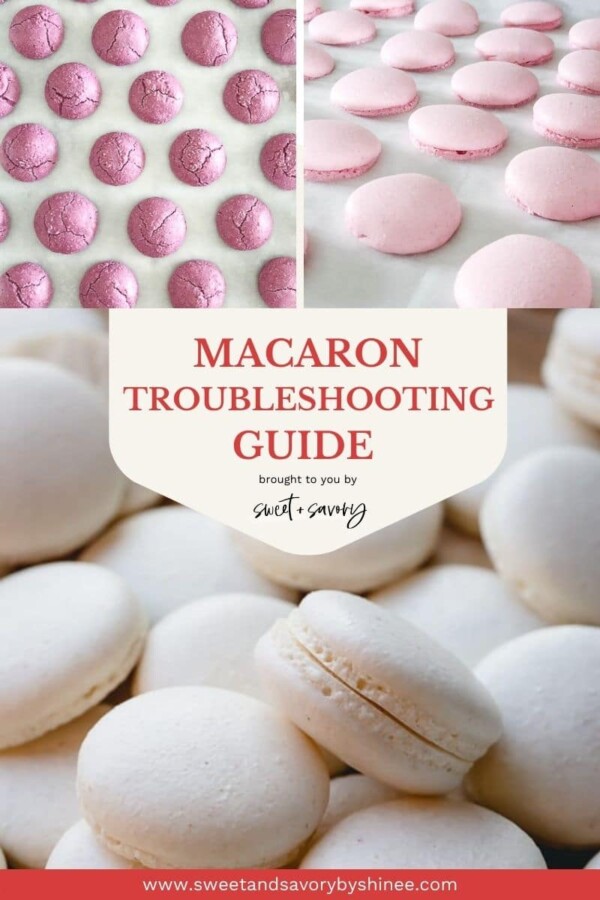
Table of Contents
Since 2012, I’ve made thousands of macarons in my home kitchen with many trials and errors, as well as picture-perfect macarons! And yes, I’ve had pretty much every problem imaginable!!
In the process, I’ve gained lots of tips and tricks to solve those frustrating issues and, most importantly, how to avoid them in the first place.
Remember, sometimes, macarons fail for no apparent reason and leave us scratching our heads.
But I encourage you to never give up on macarons. The joy of watching your macarons grow those ruffled feet and pulling out perfectly round macarons with shiny smooth tops is simply priceless.
I swear, every single time, when I see my macarons through the oven door puffing up and baking perfectly, I can’t help but do a little happy dance in my kitchen! Pure joy, I’m telling ya!
What’s a perfect macaron?
Perfect macaron is very subjective. To me, a perfect macaron has the following characteristics:
- Smooth shells
- Ruffles feet
- Full inside
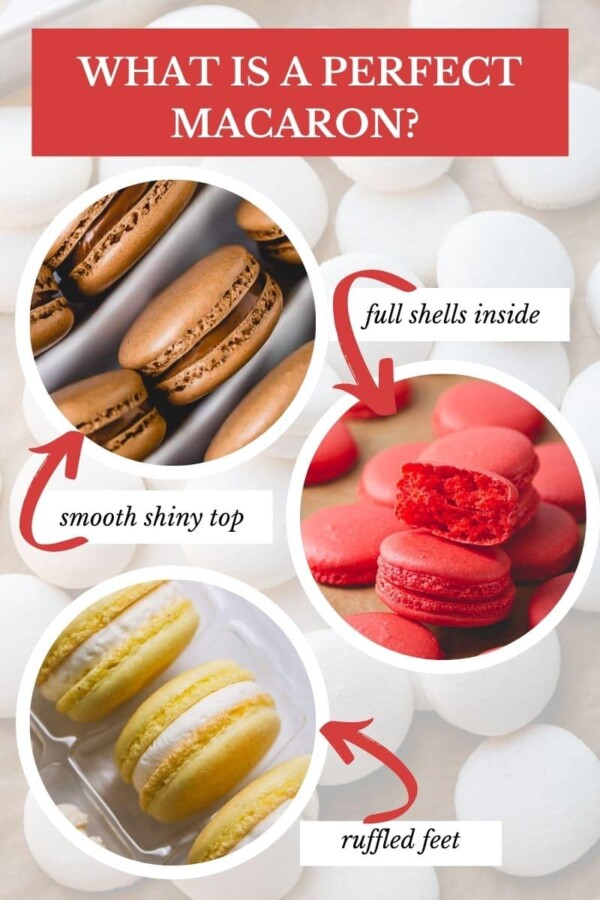
Macaron Troubleshooting Video
Visual Macaron Troubleshooting Guide
Ok, let’s discuss each of the most common macaron issues, their causes and how to fix or prevent them!
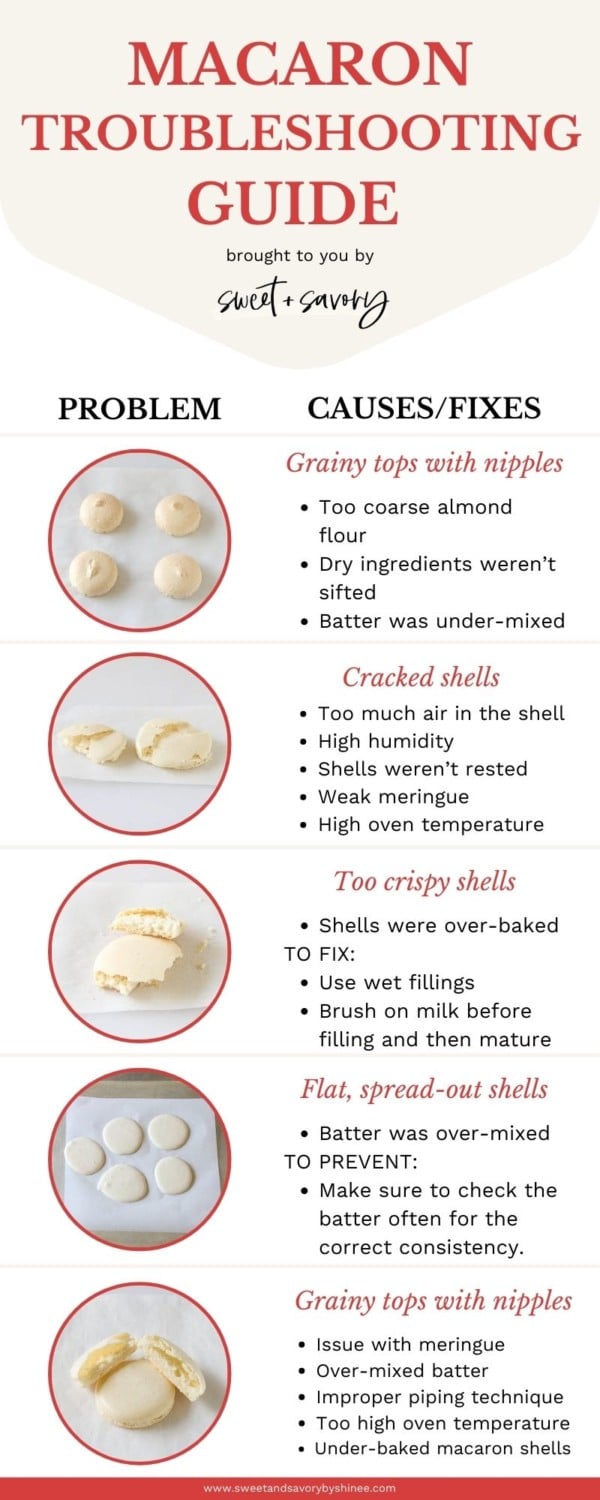
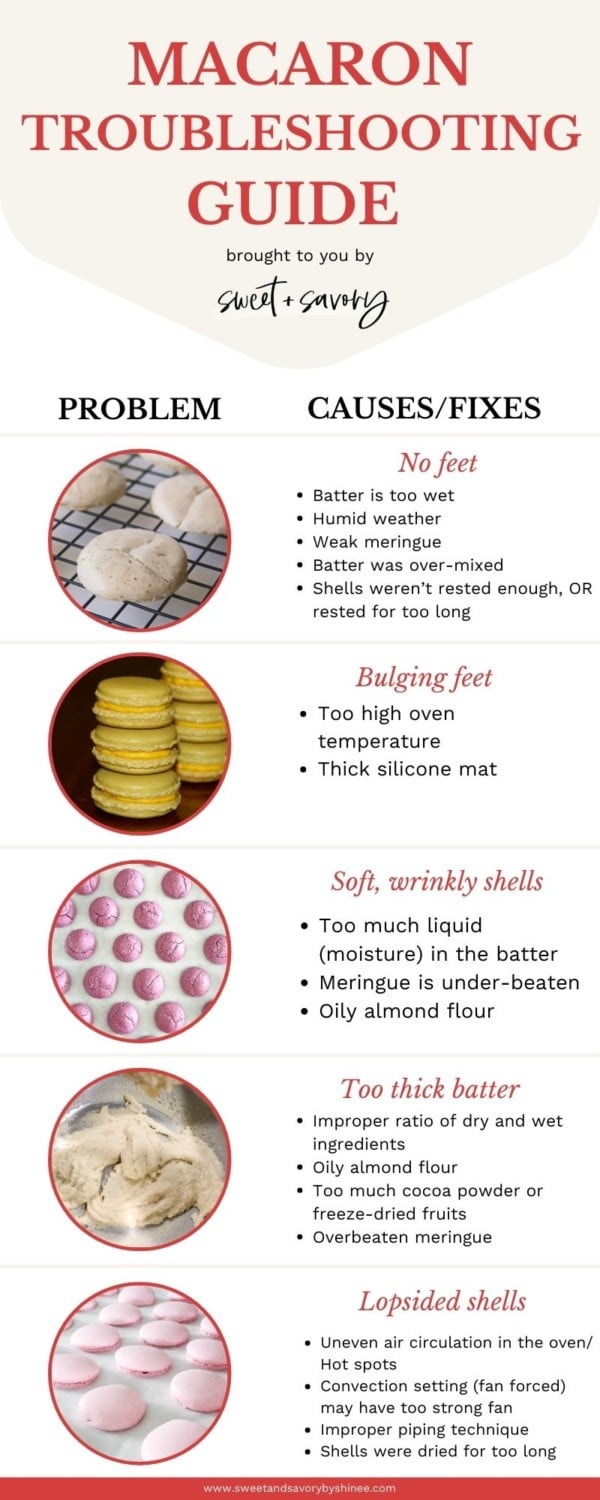
Pin this now to find it later
Pin ItUneven, grainy macarons with nipples
Possible causes:
- Too coarse almond flour
- Dry ingredients weren’t sifted
- Batter was under-mixed
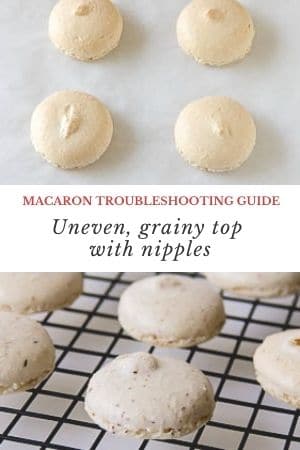
how to fix grainy shells with nipples:
- Make sure to use fine ground almond flour.
- Don’t skip sifting the dry ingredients! Toss large almond pieces left in the sifter. You shouldn’t have more than 1/2 tablespoon of almond bits.
- Under-mixed batter also causes grainy shells with nipples. When mixed right, the nipples should melt back into the batter after tapping the piped shells on the counter.
don’t do this!
Never use wet fingers to push the nipples down. Instead, use a toothpick to encourage the batter even out.
Cracked shells
Possible causes:
- Too much air in the shell
- High humidity
- Shells weren’t rested
- Weak meringue
- High oven temperature, or hot spots in the oven
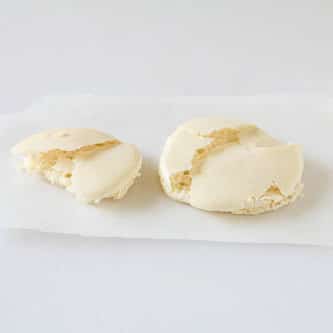
HOW TO FIX cracked macarons:
- Be sure to tap the baking sheet right after piping macaron shells. And use a toothpick to pop large air pockets visible on the surface.
- When it’s too humid, the shells don’t develop good skin, which leads to the next point.
- When the shells haven’t rested long enough to develop skin on top, steam releases from anywhere cause macarons to crack on top.
- Take your time to make nice and sturdy meringue, especially when you’re making French meringue. Watch my video on French Meringue 101 to learn all the tips to make the most stable French meringue.
- Too hot oven can also cause cracks in macaron shells. Make sure to get an oven thermometer to double check the temperature inside the oven without relying on what oven says.
Erupted shells
Possible cause:
- Touched the shells with wet finger to push down a pointy nipple
How to prevent erupted volcano macarons:
Never touch your unbaked macaron shells with wet fingers to push down pointy end. Instead tap the baking sheet well. And if the pointy end doesn’t melt into the batter, you can either baking them as is, or scrape the batter back into a bowl and mix for a little more until the batter is at correct consistency.
Too crispy interior
Possible cause:
- Shells were over-baked
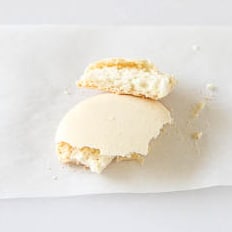
How to fix too crispy shells:
If you over-baked your macaron shells and now they’re super crispy throughout, don’t fret! 2 easy fixes:
- Use wet fillings, like jams, caramel sauce, or lemon curd in the center.
- Simply brush on milk on the bottom of the shells before piping a filling of choice.
Tip
Mature filled macarons for 24 hours. The shells will absorb the moisture from filling and macarons should soften nicely.
Flat shells, spread out too much
Possible cause:
- Batter was over-mixed
Over-mixed batter is too loose and the shells don’t hold its shape well, instead it spreads out too much.

How to prevent flat, spread out macarons:
Once macaron batter is over-mixed and it’s too runny, there’s no way to salvage it. So it’s important to prevent this from happening.
Make sure to check the batter often for the correct consistency. It should slowly run off the spatula into a ribbon, and the edges should melt back into the batter within about 10 seconds.
Hollow shells
Possible cause:
- Issue with meringue
- Over-mixed batter
- Improper piping technique
- Too high oven temperature
- Under-baked macaron shells
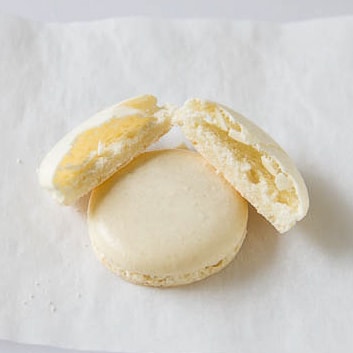
How to fix hollow macaron shells:
Hollow macarons are so common, and I personally battled with this issue for a long time. Now, I consistently get full, meaty macarons straight from the oven.
Since it’s a complex issue, I dedicated a separate post on how to fix hollow macarons.
No feet
Potential causes:
- Batter is too wet
- Humid weather
- Weak meringue
- Batter was over-mixed
- Shells weren’t rested before baking
- Shells were rested for too long, weakening the meringue structure
- Too low oven temperature
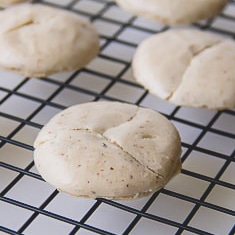
How to prevent no feet macarons:
- When the batter is too wet, macarons don’t develop those ruffled feet. The most common causes for wet batter: excess liquids, like extracts, lemon/lime juice, liquid food coloring, too much gel food coloring, etc.
- In some cases, especially in humid climates, aging egg whites might be beneficial. During aging, egg whites loose some of its moisture.
- When the meringue isn’t whipped to stiff peaks, it doesn’t have strong enough structure to lift macarons. Watch my French Meringue 101 video for visual cues for proper meringue.
- When macaron batter is over-mixed, there’s not much air bubbles left to give the shells lift during baking. Therefore, they come out flat without feet.
- Also, if macarons weren’t rested to form a skin before baking, it could cause no feet macarons. And if the shells were rested for too long, it can also negatively affect the batter, because meringue loses its stability when sat for too long. Keep checking the shells every 15 minutes and put them in the oven as soon as they don’t stick to your fingers.
- If the oven is not hot enough, macarons won’t rise as air bubbles in the meringue need heat to expand to lift the shells, creating that pretty feet at the base.
Tip
Make sure to get an oven thermometer to double check the temperature inside the oven without relying on what oven says.
Bulging feet
Potential causes:
- Too high oven temperature
- Silicone mat
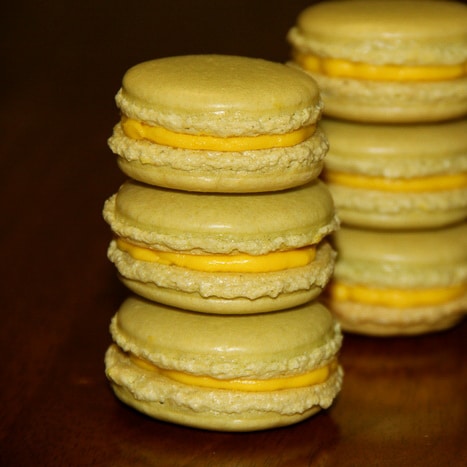
how to prevent bulging feet:
Some may find it ugly when the ruffled feet extends out of the macaron shells. I’m not a huge fan, but it’s not the worst!
- This happens when the oven is a bit too hot, causing the macarons to rise too high and then collapse slightly, making the feet bulge out.
- And another reason is silicone mat might be the culprit. I certainly happens to me with thick silicone mats, but I know some people have gorgeous macarons with silicone mats.
Soft, wrinkly shells
Possible causes:
- Too much liquid (moisture) in the batter
- Meringue is under-beaten
- Oily almond flour
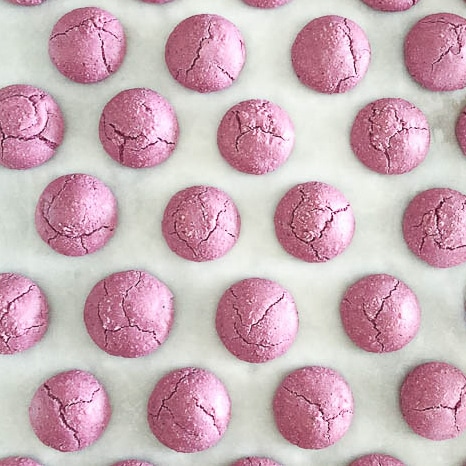
How to prevent soft, wrinkly shells:
Excess moisture and/or fat is the #1 cause for soft, wrinkly shells. And there’re number of culprits for excess moisture/fat in the batter:
- Adding liquid extracts, juices or liquid food coloring
- Adding cocoa powder, freeze-dried fruits, etc.
- Under-mixed meringue also contains too much moisture
- Oily almond flour, or almond flour that has been opened for too long
Cocoa powder contains fat which could potentially cause soft, brownie-like macaron shells. And freeze-dried fruits absorb moisture from the air fast and could cause soft, wrinkly shells as well.
Tip
Store opened almond flour in an airtight container in a cool place.
Too Thick batter
Typically, when you add dry ingredients into meringue, it starts out pretty thick and that’s totally normal. As you fold the batter, it thins out and gets runnier.
In rare occasions, the batter never loosens and it stays thick.
Possible causes:
- Improper ratio of dry and wet ingredients
- Oily almond flour
- Too much cocoa powder or freeze-dried fruits
- Overbeaten meringue
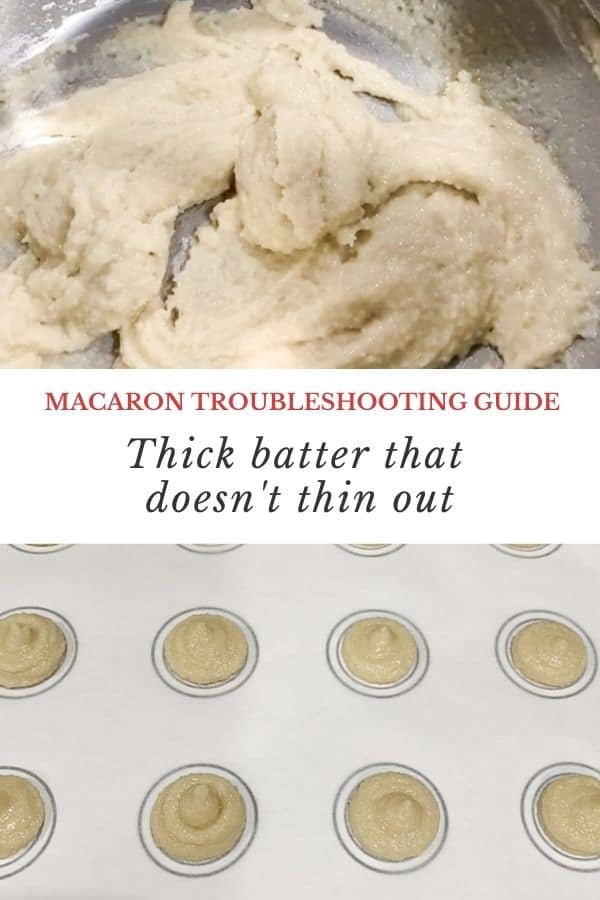
how to fix and prevent thick batter issue:
- Be sure to weigh the ingredients carefully. I strongly recommend weighing all the ingredients, including egg whites, with a kitchen scale.
- Oily almond flour could cause thick batter. Make sure to use fresh almond flour and avoid processing it in a food processor.
- Too much cocoa powder or freeze-dried fruits can throw the ratio of dry and wet ingredients.
- When meringue is over-beaten, it gets dry, throwing off the ratio as well.
Blotchy shells
I don’t have a photo of this issue, but basically it looks like greasy stains on the shells.
Possible causes:
- Oily almond flour
- Batter sat out for too long before piping
how to prevent blotchy macarons:
- Use fresh almond flour that’s not oily. To test, squeeze some almond flour in your hand and see if it holds its shape. If it holds its shape like wet sand, then it’s too oily.
- Make sure to pipe the shells right away, especially with French meringue batter.
Lopsided shells
Possible causes:
- Uneven air circulation in the oven/ Hot spots
- Convection setting (fan forced) may have too strong fan
- Improper piping technique
- Shells were dried for too long
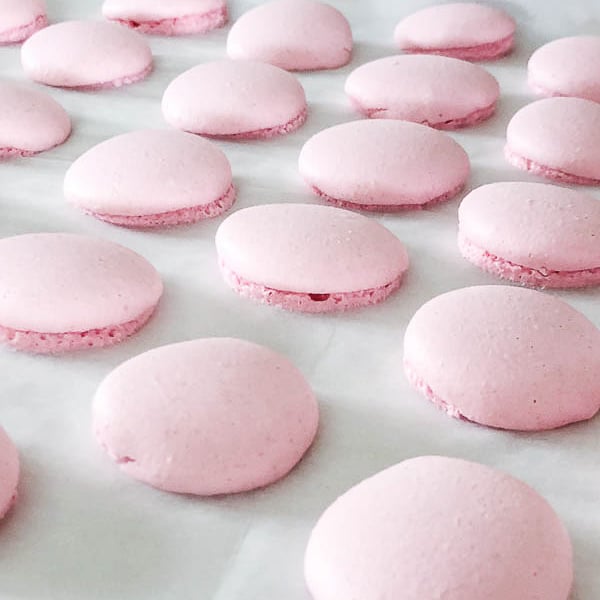
how to prevent lopsided macarons:
Main culprit for lopsided shells is poor air circulation. This could be due to uneven heat distribution and hot spots in the oven, convection settings with too strong fan. Here’re a few things you can do in this case:
- Flip the baking sheet upside down before piping macarons, so that there’s no edges around the sheet to block any heat circulation.
- Bake macarons one sheet at a time.
- Turn the baking sheet around half way through baking.
- If possible, bake on conventional setting, heat coming from top and bottom.
The next reason for lopsided macarons is improper piping technique. Pay close attention to following:
- Hold the piping bag with macaron batter straight at 90° and squeeze the batter from the top to one spot until the desired size reaches. Watch my macaron video for better illustration.
- Pipe the shells at least half an inch apart to give the shells enough room for air circulation.
And lastly, don’t dry your macarons for too long. Too thick skin may cause lopsided macarons.
Concaved (Inverted) shells or Stuck To Parchment
Possible causes:
- Low oven temp/ low heat from bottom
- Under-baked shells
- Not cooling the macarons before removing from parchment paper
How to prevent concaved, or stuck macarons:
- Make sure your oven is hot enough. Most of the time, ovens need good 30-45 minutes to preheat properly. Even if it beeps when it’s preheated, I highly recommend double checking with an oven thermometer.
- Be sure to check the macarons for doneness before taking them out. To test for doneness, gently touch the top of one macaron with your index finger and try wiggle it. If it wobbles side to side, they’re not ready. keep baking for another minute or so. The cooked shells should wiggle ever so slightly and firm to touch. When in doubt, cook a bit longer. In my opinion, it’s better to over-bake them than under-bake them.
- Make sure to cool the macarons on the baking sheet for at least 10 minutes before removing from parchment paper/silicone mat.

Whew, are you still with me? Thank you!!! I hope this macaron troubleshooting guide answers your questions and helps you to perfect your macaron skills.
And if there is anything I haven’t covered, please leave me a comment below. I’d like us, macaron-lovers, connect and discuss various problems we face baking macarons. Let’s get the discussion started.
More Favorites from Sweet & Savory
This post was originally published on December 21st, 2015, and last updated on February 16th, 2021.


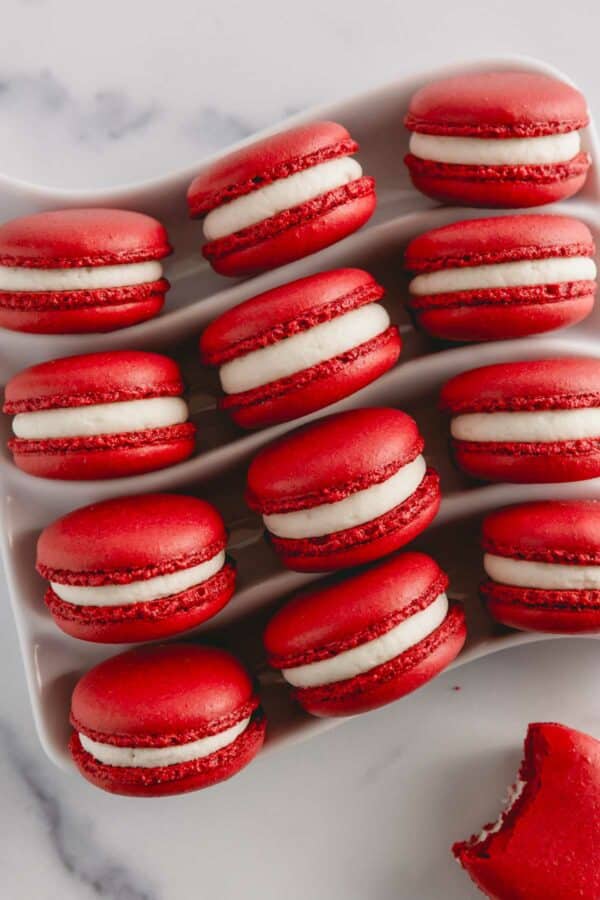
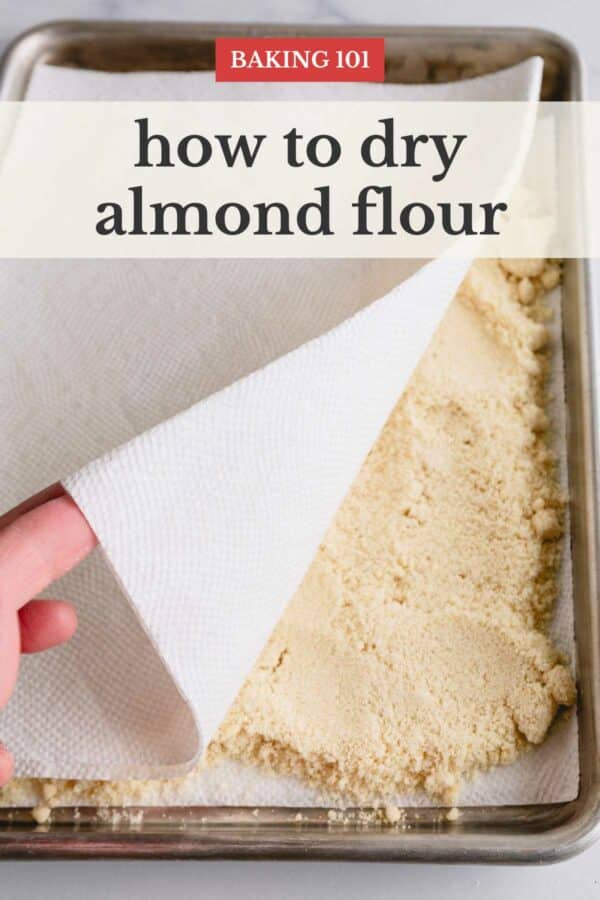


Hi Shinee! I’ve been baking macarons for about 2.5 years now. The last couple of weeks, I’ve been getting macarons that are so soft on top to where they break so easily and/or they looks like crinkled paper. They look perfect in the beginning while baking but around mid baking, they start to get little dips in them. I’ve noticed but don’t know if it’s coincidence that when my macarons turn out like that, but they take way too long to dry. Sometimes I’ll have 1 good tray but the other tray is crinkled and it’s from the same batch. I can send you pics if you want to see. Another thing is hollows. I tried turning up my temperature but they brown. I’m getting really frustrated, hope you can help! Thanks in advance.
Sounds like an issue with humidity. Has anythinng changed with your house in the last couple of weeks? If the macarons don’t form a skin, they won’t have the strength to withstand the release of steam and the tops won’t be nice and shiny. Just a thought. I have a major issue with hollows so I’m no expert, but my house is quite dry and my piped macarons dry in less than 10 minutes. The dehumidifier is always running. Has your heat source changed? Some produce more moisture than others. I sure hope you can get it figured out…there’s not much out there more satisfying than seeing a perfect batch of these babies 🙂
Thanks for your response. The only change is the weather, it’s been super cold so we have the heater running off/on all day. On days I bake, I do turn on my dehumidifier. I do notice that my macarons take long drying but there were trays that dried for a longer time and was really dry and still turned out like that. I don’t add much to the shell. Just color. No flavorings at the moment. I’ve talked to other bakers and they all said different things, too much moisture in my almond flour, too much moisture in my egg whites etc. I’m really lost.
Shinee is the expert but I will throw a couple things out there just because I am experiencing hollows as well. Did you colour the two trays differently? Have you changed your food colouring? Some just aren’t good options and aren’t meant for baking, only icing. Did you change up bowls or your spatula to mix the batter? It may sound like small things but meringue whipped in say a plastic bowl won’t whip up the same as on a stainless steel bowl. Are you bringing your eggs to room temperature, aging them at all? Have you tried making a small batch with absolutely nothing else added? No colour, no flavouring, just the bare ingredients? This will help you exclude these other things. I also read somewhere that your house shouldn’t be too hot. Just warm and on the drier side. When I pipe mine and it’s really hot in the house, I’ll open the doors out to the deck for a bit, just to cool it down. A couple seconds of Northern Ontario air and the house isn’t insanely hot anymore. I have never had problems drying them, but I do get hollows so I feel your frustration. I certainly could never give pointers but thought it might be a goid idea to eliminate illiteracy those possibilites. Some people use a fan to gently blow air over them. Maybe that would help?
Have no isea where “illiteracy” came from in my post…lol. IPhone aito correct I suppose. What a pain…lol
That happened to me also, delicate shells breaking easily. I have baked macarons for many years now and suddenly for the first time I got delicate, thin shells some with crinkled appearance. I got a new oven and I noticed that it was to much humidity trapped inside when I baked. I solved the problem with a wooden spoon in the door.
Ann, thanks for sharing your tip! I’d have never thought to leave the oven door ajar. I’ll keep that in mind next time. 🙂
Karen, that is one problem I have yet to figure out, but I know what you mean. Because I’ve encountered that once too! The same batch and totally 2 different outcome. That thin crinkly top though is usually caused by too much moisture in the batter. Like if you add a bit too much lemon juice, vanilla extract, or liquid food coloring… But why some batches have 2 different result, I have no idea. I was just baffled me when that happened to me. I was actually recording it, so you can watch it here. As for hollows, you may be overbeating the meringue, it’s often overlooked, but consistency of the whipped egg whites is just as important. Hope this is helpful.
Omg. I hope you can help me. I tried making your basic French macarons for the first ever about 2 months ago and they came out perfect!!! I was amazed. I tried making them again, following your same recipe and when I popped them, they were sooo runny and I knew they were going to be bad. I still put them in the oven and they didn’t even raise or have feet or anything (took me over 2 hours to let them sit). I then re made them again…No feet, cracked and hallow. I’m not overheating the eggs or anything. I did it again today following the Italian method. Some were cracked, some hollow. WHAT AM I DOING WRONG? I made them.oerfect the very first time. That’s why it’s sooo frustrating. Your buttercream is amazinnngggg. Help me please.
Sorry…Meant to say pipped them not popped
Hi, Rayhana! Thanks for trying my recipe, and sorry you’re having some trouble. It sounds like you’re over-mixing the batter when you add dry ingredients into the whipped egg whites. Runny batter is 1st indication that you over-mixed it. Again, no feet, cracked and hollow, all signs indicate over-mixed batter. So next time, fold the batter slowly and check often. The first time you made it, you probably were very careful and mixed the batter just right. 🙂 Also when you said it took over 2 hours to dry them, was it a humid (or rainy) day? Humid days will also affect the macarons. Hope this helps. Don’t give up, and try again.
When I bake macarons on parchment, the parchment gets a little wavy from the moisture. Then, the macarons do not have a flat bottom. There are a few lines on the bottom and they stick to the parchment there (because they are not touching the pan in those spots, i think) unless I over bake them a little. I have tried three different brands of parchment and still get this. Have you ever had this problem?
Hi, Jean. Do you live in humid climate? I kind of know what you mean, but that wavy parchment isn’t so bad that causes uneven bottom for me. I’m in drier climate though. As for sticking, I read this tip in this Laduree Macarons book. When you take out the macarons from the oven, lift one corner of the parchment paper, pour a little bit of water (not too much, or the macarons will get soggy) between parchment and hot pan. The steam will help the macarons unstick easily when cooled. I’ve tried this tip once, and it works. But I don’t always use this trick because I rarely have issue with sticking. Oh and, I use Reynolds parchment paper, not sure if it makes any difference.
Hi shinee, I love your recipes and how you make it so easy to understand the very daunting idea of making macrons. I’ve followed your recipe for lemon macrons exactly, however, they came out with cracked, rounder tops (yours are quite flat) and browning on the top and bottom, I’ve looked at your troubleshooting guide, but the problems seem to fit into many different categories… Help!
Hi, Cindi! It sounds like maybe your batter was slightly under-mixed? Rounded top sounds like the batter was still thick and prevented from spreading flat enough for smooth flat macarons. And as for cracks, I think since the batter was under-mixed, there were still lots of air trapped in the batter which could have cause cracks. Too much browning may indicate the oven might be running slightly hotter. Have you checked the oven temp with an oven thermometer? If it was only browning from the top, you could put an empty baking sheet on a rack above to shield the heat from the top. Hope this is helpful. If you need more help, feel free to send me an e-mail with a photo of your macarons, so I can help better.
Thank you so much for your reply and help, I’ve sent an email!
Thanks again!
Hi! Thanks for sharing with us your macarons steps and how tos. I was intimidated at first, but find that you instructions are super clear and easy to follow along! My 2nd batch was a success! My first was running bc I added too much lemon juice but it was still good, chewy, and had feet- just runny and spread. My question is what to level to set the oven rack on? Bottom? Middle? Thanks again!
Hi, Tiffany! So happy to hear my recipes and instructions were easy to follow, that was my ultimate goal! And congrats on your macaron success. 🙂 I bake my macarons on middle rack one sheet at a time. If you make the macarons, I’d love to see a pic and feature on my blog here.
HI Shinee, I made two batches today and they all turned out flat, no feet, and sticky. I’m sure I followed all the steps. However, the only thing I think could be a problem was that I changed the ratio as I don’t like overly sweet dessert so I cut the sugar by half. I compensated the shortage in sugar by adding more almond flour. Do you think that’s the problem?
Hi, Kristina! Yep, that’s the biggest problem. The sugar plays not only sweetening role, but it also plays an imperative role for proper structure. Macarons are finicky by nature, and you can’t change the ingredient amount whatsoever. My recipe uses much less sugar compared to other recipes, so I don’t recommend altering the recipe. Hope you give it another try.
Shinee, thank you for the reply. I don’t use fan in oven and I have tried using both parchment paper and silicone mat on double pan. Both ended with lopsided macarons. I have managed to bake macarons with proper feet using your recipe before but the last few weeks all batches have this exact similar problem. Feeling so confused.
That’s so weird. So you did get perfect macs once before? And you’re now getting the lopsided macs in the same oven with the same recipe?
Hi Shinee, I have been reading your macaron step by step guide repeatedly. Thank you so much for all the details. I have done all the steps therein. I have done several batches of macarons and I ended up with one similar problem. All the shells have feet only on one side (lopsided macarons). One side has full feet and the other side has absolutely no feet at all. Any idea? I have attempted baking with temperature ranging from 120C to 150C without success.
Hi, Junee! That’s a tough one. A few questions… 1. What kind of oven do you use? Fan? No Fan? My oven doesn’t have fan, so if yours does have a fan, I’d turn it off. 2. Also what kind of baking sheet are you using? Thin ones, thinker ones? Parchment paper, or silicone mat? I have best results when I bake my macarons on parchment paper on a thick aluminum baking sheets.
Ive been making macarons off and on for a few years with varied success. I’ve had the most success with the Italian meringue method. I get smooth shiny shells with reasonable feet. However I notice that while my first tray comes out of the oven looking great subsequent trays have issues: feet spread out more than up (especially with my fourth/last tray) and they brown more so don’t have the right color ( though I haven’t changed the oven temp). Does the batter loosen up as it sits? Any thoughts?
Hi, Alice! Do you have an oven thermometer? I think your oven might continue heating beyond the specified temp. I know my mom’s oven does that. I’d suggest getting an oven thermometer and check it. Otherwise the batter shouldn’t change its texture, unless you mix it more. Hope this helps.
I’ve been trying to perfect my macarons for awhile now.. They come out looking perfect with smooth tops and pretty Ruffled feet, but then they’re hollow! I saw the trouble shooting guide where it could possibly be related to the meringue being over beaten.. Do you have any tips as to when the meringue is just right?
Hi, Elika! I have to agree, hollow macarons seems to be one of the big problems. I know I used to get them all the time in the beginning. I did include the photo of 3 stages of meringue in the post. If that’s not helpful, watch this video that I made. Hope it helps.